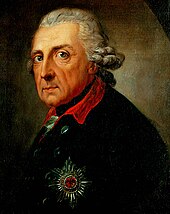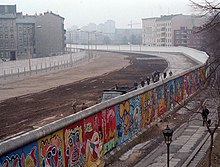User:The Show Cast/sandbox
History[edit]
The origin of the name Berlin is unknown, but it may have its roots in the language of West Slavic inhabitants of the area of today's Berlin, and be related to the Old Polabian stem berl-/birl- ("swamp").[1] Folk etymology connects it to the German Bär, a bear, and a bear appears in the coat of arms of the city.

The earliest evidence of settlements in the area of today's Berlin are a wooden beam dated from approximately 1192[2] and leftovers of wooden houseparts dated to 1174 found in a 2012 digging in Berlin Mitte.[3] The first written records of towns in the area of present-day Berlin date from the late 12th century. Spandau is first mentioned in 1197 and Köpenick in 1209, although these areas did not join Berlin until 1920.[4] The central part of Berlin can be traced back to two towns. Cölln on the Fischerinsel is first mentioned in a 1237 document, and Berlin, across the Spree in what is now called the Nikolaiviertel, is referenced in a document from 1244.[2] The former (1237) is considered to be the founding date of the city. The two towns over time formed close economic and social ties and eventually merged in 1307 and came to be known as Berlin.
In 1435, Frederick I became the elector of the Margraviate of Brandenburg, which he ruled until 1440.[5] His successor, Frederick II Irontooth, established Berlin as capital of the margraviate, and subsequent members of the Hohenzollern family ruled until 1918 in Berlin, first as electors of Brandenburg, then as kings of Prussia, and eventually as German emperors. In 1448, citizens rebelled in the "Berlin Indignation" against the construction of a new royal palace by Frederick II Irontooth. This protest was not successful, however, and the citizenry lost many of its political and economic privileges. In 1451 Berlin became the royal residence of the Brandenburg electors, and Berlin had to give up its status as a free Hanseatic city. In 1539, the electors and the city officially became Lutheran.[6]
17th to 19th centuries[edit]

The Thirty Years' War between 1618 and 1648 devastated Berlin. One third of its houses were damaged or destroyed, and the city lost half of its population.[7] Frederick William, known as the "Great Elector", who had succeeded his father George William as ruler in 1640, initiated a policy of promoting immigration and religious tolerance. With the Edict of Potsdam in 1685, Frederick William offered asylum to the French Huguenots. More than 15,000 Huguenots went to Brandenburg, of whom 6,000 settled in Berlin. By 1700, approximately 20 percent of Berlin's residents were French, and their cultural influence on the city was immense.[citation needed] Many other immigrants came from Bohemia, Poland, and Salzburg.

With the coronation of Frederick I in 1701 as king (in Königsberg), Berlin became the new capital of the Kingdom of Prussia (instead of Königsberg); this was a successful attempt to centralize the capital in the very outspread Prussian Kingdom, and it was the first time the city began to grow.[citation needed] In 1740, Frederick II, known as Frederick the Great (1740–1786), came to power. Under the rule of Frederick II Berlin became a center of the Enlightenment.[citation needed] Following France's victory in the War of the Fourth Coalition, Napoleon Bonaparte marched into Berlin in 1806, but granted self-government to the city. In 1815 the city became part of the new Province of Brandenburg.
The Industrial Revolution transformed Berlin during the 19th century; the city's economy and population expanded dramatically, and it became the main rail hub and economic center of Germany.[citation needed] Additional suburbs soon developed and increased the area and population of Berlin. In 1861, outlying suburbs including Wedding, Moabit, and several others were incorporated into Berlin. In 1871, Berlin became capital of the newly founded German Empire. On 1 April 1881 it became a city district separate from Brandenburg.
20th century[edit]

At the end of World War I in 1918, a republic was proclaimed in Berlin. In 1920, the Greater Berlin Act incorporated dozens of suburban cities, villages, and estates around Berlin into an expanded city. This new area encompassed Spandau and Charlottenburg in the west, as well as several other areas that are now major municipalities. After this expansion, Berlin had a population of around four million. During the Weimar era, Berlin became internationally renowned as a center of cultural transformation, at the heart of the Roaring Twenties.
On 30 January 1933, Adolf Hitler and the Nazi Party came to power. Nazi rule destroyed Berlin's Jewish community, which had numbered 170,000 before 1933.[citation needed] After Kristallnacht in 1938, thousands of the city's Jews were imprisoned in the nearby Sachsenhausen concentration camp or, in early 1943, were shipped to death camps, such as Auschwitz. During World War II, large parts of Berlin were destroyed in the 1943–45 air raids and during the Battle of Berlin. Among the hundreds of thousands who died during the Battle for Berlin, an estimated 125,000 were civilians.[8] After the end of the war in Europe in 1945, Berlin received large numbers of refugees from the Eastern provinces. The victorious powers divided the city into four sectors, analogous to the occupation zones into which Germany was divided. The sectors of the Western Allies (the United States, the United Kingdom and France) formed West Berlin, while the Soviet sector formed East Berlin.[9]

All four Allies shared administrative responsibilities for Berlin. However, in 1948, when the Western Allies extended the currency reform in the Western zones of Germany to the three western sectors of Berlin, the Soviet Union imposed a blockade on the access routes to and from West Berlin, which lay entirely inside Soviet-controlled territory. The Berlin airlift, conducted by the three western Allies, overcame this blockade by supplying food and other supplies to the city from 24 June 1948 to 11 May 1949.[10] In 1949, the Federal Republic of Germany was founded in West Germany and eventually included all of the American, British, and French zones, excluding those three countries' zones in Berlin, while the Marxist-Leninist German Democratic Republic was proclaimed in East Germany. West Berlin officially remained an occupied city, but as a corpus separatum it politically was very closely aligned with Federal Republic of Germany despite Berlin's geographic location within East Germany. West Berlin issued its own postage stamps, which were often the same as West German postage stamps but with the additional word "Berlin" added. Airline service to West Berlin was granted only to American, British, and French airlines.

The founding of the two German states increased Cold War tensions. West Berlin was surrounded by East German territory and East Germany proclaimed East Berlin (described as "Berlin") as its capital, a move that was not recognized by the western powers. Although only half the size and population of West Berlin, East Berlin included most of the historic center of the city. The West German government, meanwhile, established itself provisionally in Bonn.[11]
As a result of the political and economical tensions brought on by the Cold War, on 13 August 1961, East Germany began building of the Berlin Wall between East and West Berlin and similar barriers around West Berlin, and events escalated to a tank standoff at Checkpoint Charlie on 27 October 1961. West Berlin was now de facto a part of West Germany with a unique legal status, while East Berlin was de facto a part of East Germany.

Berlin was completely divided. Although it was possible for Westerners to pass from one to the other (but only through strictly controlled checkpoints) for most Easterners, travel to West Berlin or West Germany was no longer possible. In 1971, a Four-Power agreement guaranteed access to and from West Berlin by car or train through East Germany and ended the potential for harassment or closure of the routes.[12]
In 1989, with the end of the Cold War and pressure from the East German population, the Berlin Wall fell on 9 November 1989 and was subsequently mostly demolished, with little of its physical structure remaining today; the East Side Gallery in Friedrichshain near the Oberbaumbrücke over the Spree preserves a portion of the Wall.[citation needed]
On 3 October 1990, the two parts of Germany were reunified as the Federal Republic of Germany, and Berlin again became the official German capital. In June 1991, the German Parliament, the Bundestag, voted the Hauptstadtbeschluss to move the seat of the (West) German capital back from Bonn to Berlin, which was completed in 1999.
- ^ Berger, Dieter (1999). Geographische Namen in Deutschland. Bibliographisches Institut. ISBN 3-411-06252-5.
- ^ a b "Berlin dig finds city older than thought". Associated Press.
{{cite news}}:|access-date=requires|url=(help) - ^ "Berlin ist älter als gedacht: Hausreste aus dem Jahr 1174 entdeckt". dpa. Retrieved 24 August 2012.
- ^ "Spandau Citadel". Berlin tourist board. Archived from the original on 12 June 2008. Retrieved 18 August 2008.
- ^ "The Hohenzollern Dynasty". Antipas. Archived from the original on 7 August 2007. Retrieved 18 August 2008.
- ^ "Berlin Cathedral". SMPProtein. Archived from the original on 18 August 2006. Retrieved 18 August 2008.
- ^ "Brandenburg during the 30 Years War". WHKMLA. Retrieved 18 August 2008.
- ^ Clodfelter, Michael (2002), Warfare and Armed Conflicts- A Statistical Reference to Casualty and Other Figures, 1500–2000 (2nd ed.), McFarland & Company, ISBN 0-7864-1204-6
- ^ "Agreement to divide Berlin". FDR-Library. Retrieved 18 August 2008.
- ^ "Berlin Airlift / Blockade". Western Allies Berlin. Retrieved 18 August 2008.
- ^ "Berlin official website; History after 1945". City of Berlin. Retrieved 8 April 2009.
- ^ "Ostpolitik: The Quadripartite Agreement of September 3, 1971". US Berlin Embassy. Retrieved 18 August 2008.

